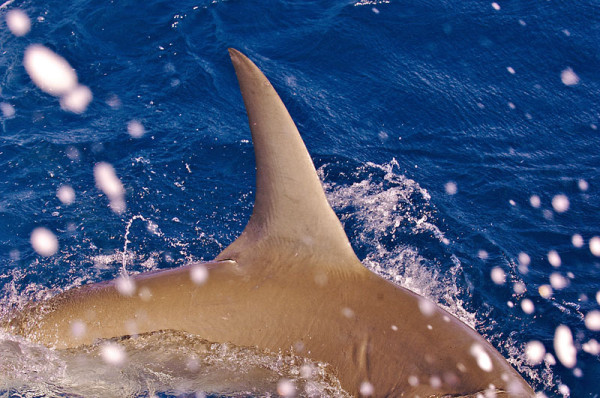After the big CITES win for sharks, what happens now?
Earlier this year, we saw a historical decision from the 16 meeting of the Parties of CITES (Convention on International Trade in Endangered Species) to regulate the international trade of five species of sharks and manta rays. WWF celebrated this move by governments around the world to conserve marine biodiversity and keep our oceans healthy. A recent TRAFFIC study also exams how implementation of trade controls through CITES regulations can help ensure the new shark and manta rays species are only sourced sustainably before entering international trade.
Great hammerhead shark fin (Sphyrna mokarran) at surface, Northern Bahamas
Four months have passed and we wanted to check in with our resident Director of TRAFFIC and Wildlife Trade, Ernie Cooper, on how WWF is helping to make this CITES listing effective and enforceable.
Tell us what this new CITES listing for sharks and manta rays means?
Five shark species and both species of mantas have been listed on CITES Appendix II, which means the 178 signatory countries of CITES must now amend their national laws to make it illegal to import or export any part of these species without the proper CITES permits. This is a major conservation success and one that has been a decade in the making. But we have to remember, right now, it’s just a list and words on a piece of paper. Implementation of this listing is critical; otherwise, we have achieved nothing. Each country, including Canada, has 18 months before the CITES listing takes into effect to get their laws in shape and the infrastructure in place to enforce those laws.
What goes on behind the scenes to make sure implementation happens?
Here in Canada, we are working closely with Canadian authorities, the IUCN Shark Specialist Group and our WWF and TRAFFIC offices around the world. What that means for an exporting country is that they have to demonstrate that trade in these species is legal and not detrimental to the conservation of these species before issuing any permits.
So first they have to determine whether the fishing of these species is sustainable or not by conducting a “non-detriment finding”. This is pretty tricky for marine species, and sharks in particular, because they are migratory animals and harder to count and keep track of in terms of their numbers. Many sharks travel through the waters of multiple countries in the course of one year. That makes things challenging. Also, keep in mind that many countries have a history of unsustainable fishing practices.
Second, they have to deal with enforcement. Countries must change their national laws to make International trade in these species without permits a national violation. In Canada, that means the Wild Animal and Plant Trade Regulations (WAPTR) must be amended, subjected to public consultation, and published.
Enforcement really comes down to the officers responsible for inspecting wildlife shipments in exporting and importing countries, and they have a tough job. For example, they need to be able to identify a dried shark fin and what determine what species of shark it came from. They also need to make sure the quantity of the product, the species and the permits all match up.
Where does WWF come in?
This is one of the top priorities for us here at WWF-Canada for the next three years. I have been very busy working with my WWF colleagues in various countries and with IUNC and other conservation groups to develop resources and identifying the information gaps for the enforcement and identification piece of the puzzle.
I have been working to determine what existing identification resources are available to help enforcement officers to identify different types of shark fin and what still needs to be developed. For example, I’m in touch with some Ph. D students in Australia who are doing interesting studies on morphology and DNA that might be applicable. I’m in regular contact with the folks at Department of Fisheries and Oceans and Environment Canada. This is all very exciting stuff and this is one example of what real conservation work looks like!
WWF-Canada’s conservation efforts, including Ernie’s work on sharks and manta rays, are supported by funds like those generated from the BMO® WWF-Canada Affinity Card Program. Apply for a BMO WWF-Canada AIR MILES®† MasterCard®* by August 31, 2013 and earn 500 Bonus AIR MILES reward miles when you spend $200 or more in card purchases by October 31, 2013. If you already have a card, we thank you for supporting WWF’s work here in Canada and around the world.


